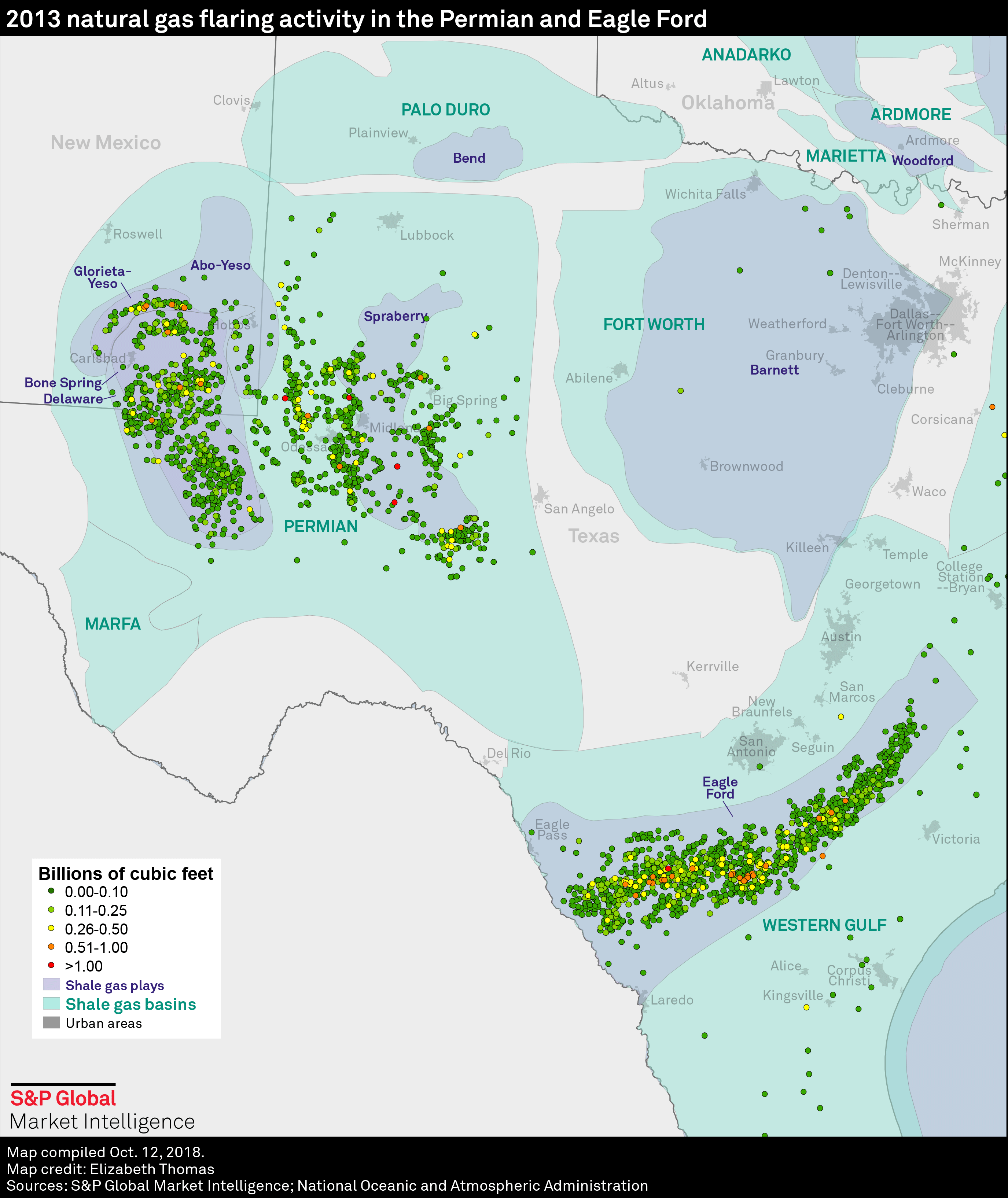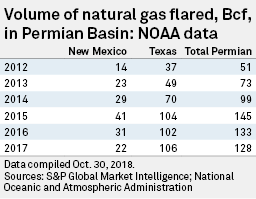Infrastructure insufficiency may have driven some oil producers in Texas and New Mexico portions of the Permian Basin to flare significant volumes of associated gas to allow oil production to grow while producers seek avenues to deal with ongoing gas transportation constraints. Natural gas takeaway capacity remains insufficient in many areas, especially in the Delaware sub-basin, where abundant gas is co-produced with oil. Infrastructure is also less developed than in the Midland sub-basin of the Permian, where conventional oil development has been constant for close to 100 years. The Delaware has substantially less gas processing and transportation infrastructure than the Midland; it did not undergo long-term development of conventional resources as did the Midland and only recently became a center for unconventional development when the shale revolution began in earnest a few years ago.

Texas producers may have flared 468 Bcf of associated gas from 2012-2017
Satellite-derived natural gas flaring information, aggregated by S&P Global Market Intelligence from data sourced from the National Oceanic and Atmospheric Administration, or NOAA, points to 468 Bcf of gas flared over the years 2012-2017 in the Texas Permian Basin. The average annual burn over these years was 78 Bcf, and the total annual burn climbed to 106 Bcf of gas in the Permian Basin in calendar-2017. This represents a 4% increase from the 102 Bcf burned in 2016 and a 2% increase from the 104 Bcf ignited in 2015.
According to U.S. Energy Information Administration data, Texas oil production reached 4.47 million barrels per day in July, representing a 30% increase in production for the state compared to the year-ago period when production averaged 3.44 MMbbl/d. Texas statewide natural gas production grew 10% year over year to 24.6 Bcf/d on a gross withdrawal basis compared with the July 2017 average production of 22.4 Bcf/d. The volume of natural gas purged through flaring in 2017 equates to roughly four days of statewide gross gas production.
Considering the accelerated pace of production activity in the Permian Basin for much of 2018 and the continued constrained takeaway capacity from the region as gas supplies burgeon, an upward creep in gross flaring level is likely inescapable this year.

NM gas flaring in the Permian over the years 2012-2017 totaled 160 Bcf
New Mexico flared 22 Bcf of natural gas last year in the Permian Basin, according to analysis of NOAA data. While this represents a 27% decrease over the 2016 level of 31 Bcf, flaring in the New Mexico section of the Permian is likely to increase in 2018. Indeed, EIA data indicate a nearly 50% increase in crude oil production in the state in July to 669,000 barrels per day from an average of 447,000 bbl/d in 2017. Gross natural gas production rose 17.6% to 4.3 Bcf/d in July from an average of 3.6 Bcf per day gross withdrawals in the year prior.
New Mexico flared an average of 27 Bcf each year from 2012-2017, with a peak of 41 Bcf attained in 2015. Total natural gas flared over the years 2012-2017 was 160 Bcf. While decreased flaring has occurred in 2016 and 2017 relative to 2015, New Mexico gas flaring levels may be on the upswing this year considering the large increases in oil and gas production in 2018.
For additional information and context regarding satellite-derived assessment of natural gas flaring activity in Texas, New Mexico and North Dakota, please refer to our recent articles "Are some shale producers under-reporting gas flaring to keep oil flowing?" and "Texas kept lid on flaring in 2017, North Dakota grappled with burn-rate near 20%."
Regulatory Research Associates is an offering of S&P Global Market Intelligence.
For a full listing of past and pending rate cases, rate case statistics and upcoming events, visit the S&P Global Market Intelligence Energy Research Home Page.
For a complete, searchable listing of RRA's in-depth research and analysis, please go to the S&P Global Market Intelligence Energy Research Library.



